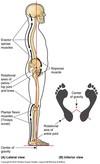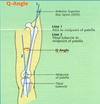Exam 1 Spring Flashcards
(154 cards)
Inferior innominate shear
§side with the POSITIVE standing flexion test.
- ASIS on affected side is inferior
- PSIS on affected side is inferior
- Pubic rami on affected side may be inferior
Ischial tuberosity inferior



Seated & Standing Flexion Tests: sacrum & ileum
Sacrum-
- seated FT lower extremities = not influencing SIJ
- positive test indicates the side (lateralization) but not the specific dysfunction, of sacroiliac dysfunction.
Ilium-
- during the standing FT the lower extremities = influence SIJ
- positive test indicates an iliosacral SD, or excessively tight contra-lateral hamstrings.
Joints significant in gait

-Deep sulcus and post/inf
ILA are opposite so we have
an oblique axis
-The sacrum has rotated
towards the right; L5 rotated to
the left
Dx: R on R sacral torsion

Shuffling gait
typ in parkinson’s
pattern:
- small, flat-foot shuffle (less ground clearance)
- rigid, temor, pausing mvmts, shuffling with haste,
- diff: start, stop, turn
- trucal flex
1st noticable signs: non-rhyth pattern with random/poor timed arm swings
tx: L-dopa

cranial concept of pelvis
sacrum connects innominates –> occiput motion
alts affect either side: alters biomech model via dural attachement
Superior Innominate shear
§shear-named for the side with the POSITIVE standing flexion test.
- ASIS on affected side is superior
- PSIS on affected side is superior
- Pubic rami on affected side may be superior
- Ischial tuberosity superior

Ataxic gait
reeling, unsteady with wide base: tend to fall towards side of lesion
pattern:
- irreg steps
- lateral veering
- carefully watching ground
most prominent with sudden turns/stop/start
reasons:
- injury to cerebellum, SC, peripheral sensory NS
- inpair of joint position sense: afferent fibers disruption in peripheral N/posterior roots/posteiror columns of SC

Spondylolisthesis
anterior slippage of vert: usu @ L5 on S1

Low Back Pain Expanded Differential Dx (10)
PPP A A COMIC
Prostatitis
Paget’s disease
PID
AAA
Abscess
Ca lesions
Ovarian cysts/CA; endometriosis
Multiple myeloma
Infection
Compression fracture
pubic shear
subjective complaints?
caliper: gapping
subjective:
- UTI symptoms: burning, freq, fullness, weak stream, dysuria, dysparunia (painful sex)
Muscular Action during STANCE Phase

most important part of gait
flex of stance knee
if knee locked up = E expend up 50%
- another detm lost = 300% lost
Sacral/Innominate Motions during Gait
- Weight shift to the left
- Posterior rotation of innominate
- Rotation of whole pelvis to the left
- L/L sacral torsion

Innominate/Iliosacral Rock/ Compression Test

Lower Extremity Joints during Gait: Ankle
body wt = just medial of center: eversion –> inversion
Forward Sacral Torsions with Gait

Left stance leg =
Left on Left torsion
Right stance leg =
Right on Right torsion
Traumatic Sacral SD
slip/fall on butt
MVC –> F from “braking” foot –> leg –> pelvis
Anterior SIJ
synovial
different orientation than posterior/lig aspect

herniated disc
type 2 F SD –> flat lordosis –> shearing stress
rad pain –> butt
- init disinterpred as SI pain/dysfx
neuro exam important for distinguishing SI pain from disc protrusion
Forward Sacral Somatic Dysfunctions on Oblique Axis
- We have 4 possibilities for forward sacral somatic dysfunctions:
- Left on Left sacral torsion
- Left on left sacral rotation
- Right on Right sacral torsion
- Right on Right sacral rotation
what does the external oblique form distally?
inguinal lig as it txverses ASIS –> pubic tubercle


















































